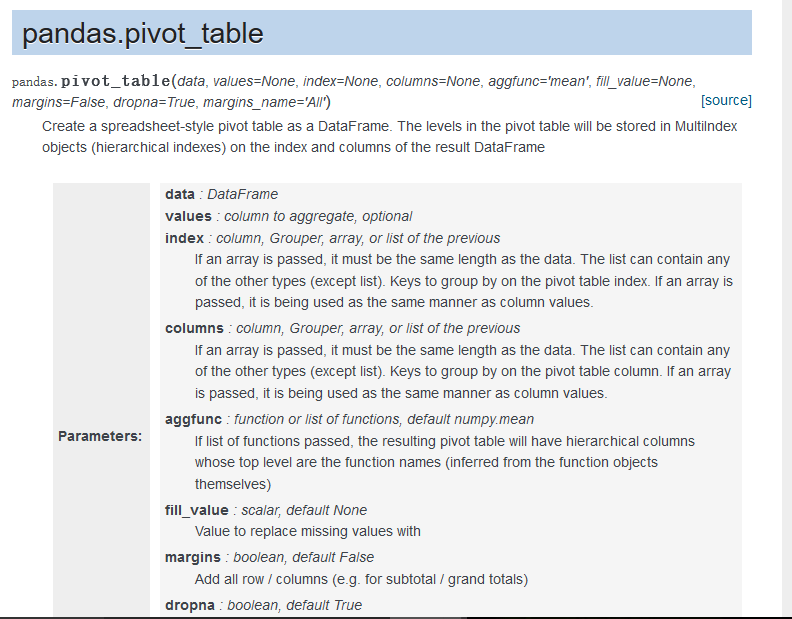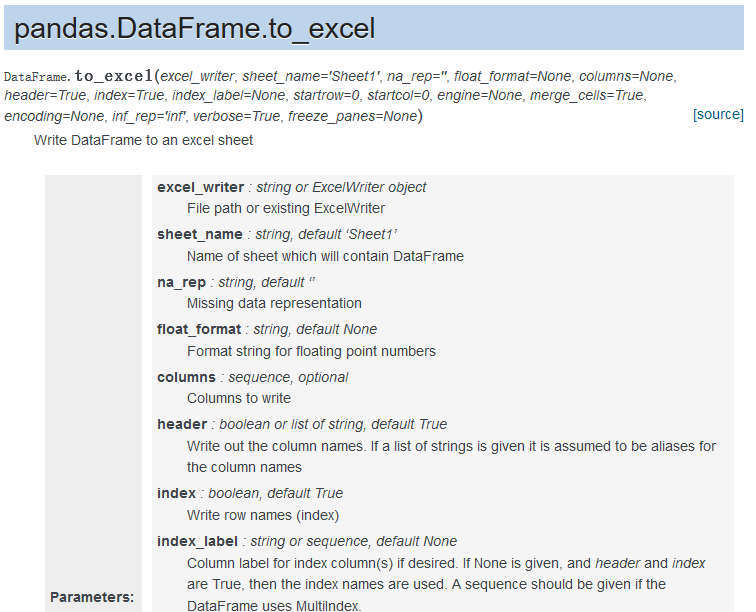最近工作上有个新需求就是按照交叉表在superset上显示的数据原样导出到Excel文档,目前最新版本的superset不支持导出交叉表格式的数据,任何导出的表都是基本的二维表格的csv,刚好最近在学习pandas这个工具。阅读文档可以看到导出提供的接口:
Pivot_table接口如下:

提供了to_excel接口可以导出支持二进制格式的xlsx文件:
根据接口参数,很容易就导出交叉表原样的excel文件。
接着上文,优化导出的表格样式,就是调用python的openpyxl库,对表格的表头做冻结,还有对交叉表的列做冻结。
直接上代码:
#定义表格样式
fill_header = PatternFill(fill_type=fills.fills[0],
start_color = '0000BFFF',#'0066CDAA',#'0020B2AA',#colors.BLUE,
end_color = 'FF000000')
fill_body = PatternFill(fill_type=fills.fills[0],
start_color='00B0E0E6',
end_color='FF000000')
col_alignment = Alignment(horizontal='center',
vertical='center',
text_rotation=0,
wrap_text=True,
shrink_to_fit=True,
indent=0)
row_alignment = Alignment(horizontal='left',
vertical='center',
text_rotation=0,
wrap_text=False,
shrink_to_fit=True, #缩放文字内容
indent=0)
border = Border(left=Side(style='thin',color='FF0000FF'),
right=Side(style='thin',color='FF000000'),
top=Side(style='thin',color='FF000000'),
bottom=Side(style='thin',color='FF000000'),
)
def style_custom(filename, rows, columns, values='', sheet='Sheet1', come_from='pivot'): # print(rows, columns, values, come_from) if come_from == 'pivot': rows = len(rows) #header列数 columns = len(columns) + 1 #header行数,metrics加上去 values = len(values) else: rows = columns= values = 1 wb = open_excel(filename) sheet = wb.get_sheet_by_name(sheet) print(sheet.max_row, sheet.max_column) max_row, max_column = sheet.max_row, sheet.max_column for col in range(rows, max_column+1): for row in range(1, columns+1): coordinate = '{0}{1}'.format(get_column_letter(col), row) sh = sheet[coordinate] # if sh.value: sh.fill = fill_header sh.alignment = col_alignment sh.border = border for row in range(columns, max_row+1): for col in range(1, rows+1): col = get_column_letter(col) coordinate = '{0}{1}'.format(col, row) sh = sheet[coordinate] # print(sh.value, type(sh.value)) # if sh.value: #and isinstance(sh.value, (int,long, basestring)): sh.fill = fill_header sh.alignment = row_alignment sh.border = border for col in range(rows+1, max_column+1): col = get_column_letter(col) for row in range(columns+1, max_row+1): if row%2 == 0: coordinate = '{0}{1}'.format(col, row) sh = sheet[coordinate] sh.fill = fill_body pass try: # sheet.freeze_panes = '{}{}'.format(get_column_letter(columns), rows+2) if come_from == 'pivot': if values == 1 and columns == 2: A, B = get_column_letter(columns + rows - 1), rows + 2 else: if rows == 1 and columns == 2: A, B = get_column_letter(columns + rows - 1), rows + 2 elif columns == 2: A = get_column_letter(columns + rows - 1) B = rows + 1 else: A, B = get_column_letter(columns + rows - 2), rows+1 if rows == 1: B += 2 else: A, B = "A", "2" sheet.freeze_panes = '{}{}'.format(A, B) #(columns, rows)做冻结表头用 wb.save(filename) except IOError as e: print("IOError ******************** :%s"%e)
来张pivot_table导出效果图:

千里之行始于足下,成长就是守护和付出的过程,人生苦短,我用Python。



